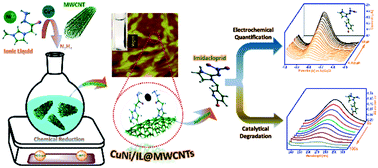Detection and detoxification of imidacloprid in food samples through ionic liquid-stabilized CuNi alloy nanoparticle-decorated multiwall carbon nanotubes†
Abstract
The development of resourceful catalysts with effective quantification as well as the detoxification of insecticides is a major challenge in terms of food safety and sustainable agriculture. The present study reports the development of ionic liquid-stabilized CuNi alloy nanoparticle-decorated MWCNTs (CuNi/IL@MWCNTs) via a simple reduction method and the characterization techniques confirm the morphology, size and oxidation state of CuNi/IL@MWCNTs. Furthermore, the CuNi/IL@MWCNTs/glass carbon electrode (GCE) showed selectivity and excellent electrocatalytic activity towards imidacloprid (IMD), resulting in exceedingly low limit of detection (11 nM), good stability, and wide linear range (0.0125–240 μM) for the detection of imidacloprid. Interestingly, CuNi/IL@MWCNTs also show excellent recovery results (97.4–101.2%) in spiked corn and rice samples. In addition to the quantification of IMD, the CuNi/IL@MWCNTs achieved almost complete degradation (up to 99.6%) behavior to detoxify the IMD in an aqueous system in 100 s with good reusability. Confidently, the proposed study can provide a functional material for the sensitive detection and quick detoxification of low concentration IMD in food samples in developing and remote areas.

- This article is part of the themed collections: Environmental Science: Nano Recent HOT Articles and RSC Environmental Science journals: Highlights from India


 Please wait while we load your content...
Please wait while we load your content...